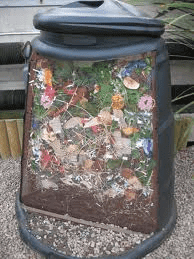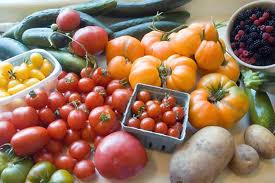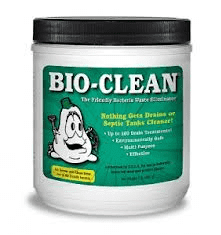Composting and Bio-Clean
When we talked about garbage disposals a little while ago, we learned that putting your vegetable peels and food waste down the garbage disposal is actually a pretty “green” way to deal with them. But I also mentioned that an even greener way to deal with your kitchen scraps is to make compost!
Compost is completely decayed organic matter that can be used to condition soil. It is dark, has no odor, and is packed with nutrients. It doesn’t sound very glamorous (decay never does) but it can absolutely make the difference between a sad pale tomato and a prize worthy vibrant, healthful one.
If you are only gardening indoors, or on a balcony, you can still compost! If you only have a few dollars to spend on it, you can compost! If you don’t have any money to spend on it- you can still compost. All that you need to make it happen is a container (for indoor composting) and a little basic knowledge.
 If you just took your strawberry greens, zucchini peels, and melon rind and threw it in a bucket you would probably eventually get compost. More likely and more quickly you’d get a smelly moldy mess.
If you just took your strawberry greens, zucchini peels, and melon rind and threw it in a bucket you would probably eventually get compost. More likely and more quickly you’d get a smelly moldy mess.The smell comes from the anaerobic break down of food; the mold comes from cool, dark, wet places.
So to avoid the smell all you have to do is allow as much air as possible to contact the compost. You can poke holes, stir, shake, or turn it. To avoid the mold you just have to expose it to warmth and light. You will also want to drain off the nutrient-rich “compost tea” (and use that in your garden) to keep the compost from being too wet.
If you want to try composting indoors, try modifying the mason jar compost experiment found HERE, or you can try a bucket, trash can or a commercially available compost bin.
For outdoor composting, you can use a large bin or trash can, a compost turner, or just make a compost heap. A compost heap is literally a pile of compost in your yard. You can aerate it with a shovel or rake.
 The ideal temperature for quick, odor-free compost is thought to be between 120-160 degrees. A hot Southern California summer is perfect, but don’t fret if the temperature drops. The compost also creates its own heat because of the activity that happens in the compost.
The ideal temperature for quick, odor-free compost is thought to be between 120-160 degrees. A hot Southern California summer is perfect, but don’t fret if the temperature drops. The compost also creates its own heat because of the activity that happens in the compost.
Microorganisms are what make the food trash, newspapers, and other discards into gardeners gold, so depending on the initial size of the discards and the size of the heap, you may or may not want worms involved. Worms break the compost into smaller pieces, and then the microorganisms do the rest.
So how much trash space can you save and how much stuff can you put into a compost bin? You can put vegetable peels, coffee grounds, newspapers, eggshells, and any type of fruit or vegetable. Some people even compost meat and many people buy additives to help with the process. The more you break it down before you throw it in the heap, the quicker the process will happen.
There are a lot of expensive products out there that promise to speed the process, eliminate odors, and practically do your composting for you. But did you know that there is something that you might have under your sink already that will deliver better results than anything you can buy at Home Depot?
If you’ve had us out for an inspection or a drain line problem, chances are you’ve at least seen Bio-Clean.
 Bio-Clean is generally used to keep drain lines running smoothly, but the way it works makes it a perfect compost helper, too. It is all natural, eco-friendly, and safe for every living creature. It is a highly concentrated (the highest available) powder filled with enzymes and friendly bacteria that do not attack living cells or inorganic material. You can touch it, eat it, even accidentally inhale it and it won’t do anything to you. You can store it in a plastic baggie and it won’t eat through it. You can throw it in your compost heap and your worms will be safe but the cellulose (paper) and your kitchen scraps will be broken down into odor-free compost by “Clean Gene” and his army.
Bio-Clean is generally used to keep drain lines running smoothly, but the way it works makes it a perfect compost helper, too. It is all natural, eco-friendly, and safe for every living creature. It is a highly concentrated (the highest available) powder filled with enzymes and friendly bacteria that do not attack living cells or inorganic material. You can touch it, eat it, even accidentally inhale it and it won’t do anything to you. You can store it in a plastic baggie and it won’t eat through it. You can throw it in your compost heap and your worms will be safe but the cellulose (paper) and your kitchen scraps will be broken down into odor-free compost by “Clean Gene” and his army.If you already have a tub of this drain line (and garden!) helper, give it a try. It’s used to turn sewage spills into garden worthy compost, and while we don’t recommend holding onto sewage for any reason, you can rest assured that a sprinkle of this stuff will accelerate your compost while still being the safest and most reliable drain maintenance product you can buy. If you don’t already have Bio-Clean and you want it, or want to know more, give us a call. We can send a technician out to not only deliver it, but he’ll also teach you how to use it properly, and apply the first treatment at no additional charge.
Of course, you don’t need to use any product at all! 
If you have a whole house water filter with a self-cleaning cycle (such as the HALO water system) you can save even more money and use that water (which is just as de-chlorinated and filtered as the water that comes out of your taps) to water your new garden. Next time we’ll talk about whole house filters and how they can improve everything from your garden to your hair and nails to your overall health! Of course, if you can’t wait that long, give us a call, we’ll be happy to talk to you about them or send someone out to show you how they work.



